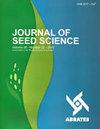An alternative approach to conducting germination tests on chemically treated and untreated stored cotton seeds
IF 1.2
4区 农林科学
Q3 AGRONOMY
引用次数: 2
Abstract
Abstract: The objective of this study was to assess the impact of incorporating vermiculite into germination tests for both chemically treated and untreated stored cotton seeds. To that end, two independent experiments were conducted using cotton seeds of the cultivar DP1746B2RF under chemical treatment with a mixture of fungicide, insecticides, and nematicide; and both experiments were set up in a completely randomized design with four replications. In Experiment 1, the objective was to determine the ideal water volume for moistening the vermiculite. Four water volumes were used: 1.5, 2.0, 2.5, and 3.0 times the weight of the dry vermiculite. Experiment 2 was conducted in a 2 × 2 × 2 triple factorial arrangement consisting of two substrates (germitest paper and germitest paper + vermiculite), two treatments (chemically treated seeds and untreated seeds), and two storage periods (0 and 150 days). First germination count and germination were evaluated in the two experiments. From the results found in Experiment 1, the water volume corresponding to 3.0 times the weight of the vermiculite provided the best conditions for germination. In Experiment 2, the most appropriate substrate for conducting the germination test of untreated and chemically treated cotton seeds is vermiculite, which led to rapid germination and uniform seedling development.对化学处理和未经处理的棉花种子进行发芽试验的另一种方法
摘要/ Abstract摘要:本研究旨在评价在化学处理和未经化学处理的棉花种子中加入蛭石对发芽试验的影响。为此,以DP1746B2RF品种的棉花种子为研究材料,分别用杀菌剂、杀虫剂和杀线虫剂混合化学处理,进行了两次独立试验;两个实验都是完全随机设计的,有四个重复。在实验1中,目的是确定湿润蛭石的理想水量。使用四种水体积:1.5、2.0、2.5和3.0倍的干蛭石重量。试验2采用2 × 2 × 2三因子试验,包括2种基质(胚纸和胚纸+蛭石)、2种处理(化学处理和未处理)、2个贮藏期(0和150 d)。在两个试验中对首次萌发计数和萌发率进行了评价。从实验1的结果来看,3.0倍蛭石重量对应的水量为萌发的最佳条件。在试验2中,未经处理和化学处理的棉花种子进行发芽试验时,最适宜的基质是蛭石,其萌发速度快,幼苗发育均匀。
本文章由计算机程序翻译,如有差异,请以英文原文为准。
求助全文
约1分钟内获得全文
求助全文
来源期刊

Journal of Seed Science
Agricultural and Biological Sciences-Agronomy and Crop Science
CiteScore
2.00
自引率
30.00%
发文量
28
审稿时长
12 weeks
期刊介绍:
From 2017 the Journal of Seed Science (JSS) will circulate online version only.
Original scientific studies and communications, not yet published or submitted to another journal for publication and written in Portuguese or English, will be accepted for publication. For manuscripts submitted in English, the authors should provide an adequated version.
The SCIENTIFIC COMMUNICATION is a category of scientific manuscript which describes a technique, an equipment, new species or observations and surveys of limited results. It has the same scientific rigor as the “Scientific Articles” and the same value as a publication. The classification of a manuscript as a SCIENTIFIC COMMUNICATION is based on its content and scientific merit but it can be a preliminary study, simple and not definitive on a certain subject, with publication justified by its uniqueness and contribution to the area.
The Editorial Board of the JSS may invite leading authors of recognized reputation to compose specific Review Articles covering topics of their specialization that will convey to the scientific community the state-of-the-art knowledge related to the specific theme.
 求助内容:
求助内容: 应助结果提醒方式:
应助结果提醒方式:


